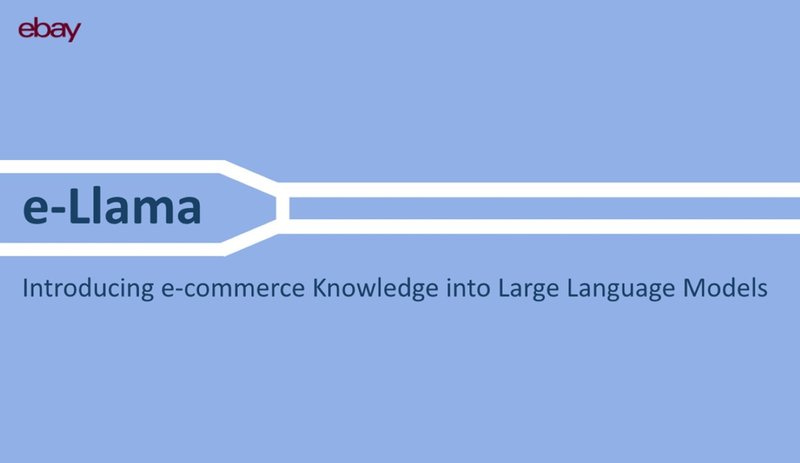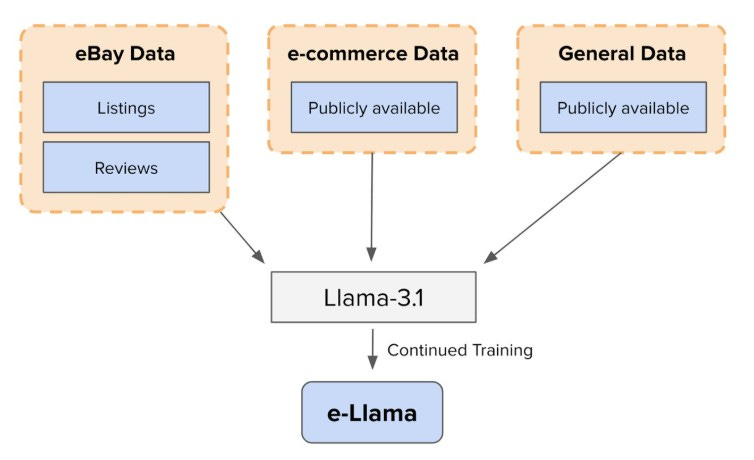eBay’s e-Llama: AI Trained on 1 Trillion Tokens, Boosting E-Commerce Accuracy by 25%
How eBay optimized AI to deliver better product matches, faster support, and more accurate pricing

TL;DR
Situation
eBay wanted a powerful AI model that understands online shopping better. Existing models like ChatGPT and Llama-3.1 were good at general tasks but lacked deep knowledge about e-commerce.
Task
The goal was to improve the Llama-3.1 model by training it with 1 trillion words of shopping-related data (like product listings and reviews) without making it worse at general tasks. They also needed a way to measure its improvement.
Action
1- Training: They took the Llama-3.1 model and kept training it with 1 trillion words related to e-commerce.
2- Testing: They created special tests focused on online shopping tasks, like predicting product prices or choosing correct product details.
3- Fine-Tuning: They adjusted the training method to balance e-commerce learning while keeping general knowledge intact.
4- Model Merging: They combined the improved model with the original Llama-3.1 model to get the best of both worlds.
Result
1- The new e-Llama model (8B & 70B versions) was much better at e-commerce tasks than the original model.
2- It kept most of its general knowledge but slightly dropped in performance on some hard non-e-commerce tasks.
3- The merging trick helped fine-tune how much general vs. e-commerce knowledge the model had.
Use Cases
Search Functionality, Enhanced Recommendation, Customer Support
Tech Stack/Framework
Llama 3.1, Megatron-LM
Explained Further
eBay’s e-Llama: The AI That Understands Online Shopping Better
Online shopping is massive, and companies like eBay are constantly looking for ways to improve how people buy and sell products. One of the biggest challenges is ensuring customers find what they need quickly while getting accurate product details. To address this, eBay developed e-Llama, a customized AI model designed specifically for e-commerce.
e-Llama is based on Llama 3.1, a language model created by Meta. However, instead of using it as it was, eBay trained it further with 1 trillion words of shopping-related data. This made e-Llama much better at understanding product listings, pricing trends, and customer searches compared to general AI models.
What is e-Llama and Why is it Important?
Most AI models today, like ChatGPT or Google’s Gemini, are good at answering general questions but lack deep knowledge of e-commerce. They might not accurately predict product prices or classify items into the correct categories.
e-Llama solves this by specializing in online shopping. It was trained on data from eBay, including product descriptions, user reviews, and transaction history, making it better at identifying product details, setting fair prices, and improving search results.
How Was e-Llama Built?
Instead of creating a new AI from scratch, eBay took Llama 3.1 and continued training it with a mix of e-Bay data, e-commerce data and general knowledge data to ensure it didn’t forget its general understanding of language.

Hardware: eBay used 480 NVIDIA H100 GPUs to train the model.
Training Framework: They used Megatron-LM, which is designed for efficiently training very large AI models.
Learning Rate Optimization: eBay tested different training speeds and settled on 3.0e-5 for the 8B model and 1.5e-5 for the 70B model for the best balance between learning and retention.
The result was two versions of e-Llama:
e-Llama 8B – A smaller, efficient version with strong e-commerce knowledge.
e-Llama 70B – A much larger model that performs well on both e-commerce and general tasks.
What Can e-Llama Do?
eBay developed e-Llama to improve key aspects of online shopping, including:
Better Search & Recommendations
e-Llama understands product descriptions and user queries better, leading to more accurate search results and personalized recommendations.
Improved Customer Support
It can help automate customer service responses, answering common questions about returns, shipping, and product availability.
Smarter Product Categorization
By analyzing product details, e-Llama sorts listings into the correct categories, reducing errors and improving browsing.
More Accurate Price Predictions
Based on past sales, e-Llama can predict reasonable price ranges for products, helping sellers price competitively.
Multilingual Support
Since eBay operates in multiple countries, e-Llama can translate listings and reviews, making cross-border shopping easier.
Results
Enhanced E-Commerce Performance: The e-Llama models demonstrated approximately 25% improvement in e-commerce-specific benchmarks for English and about 30% improvement for non-English when compared to the corresponding Llama 3.1 base models.
Minimal General Domain Degradation: The large e-Llama 70B model exhibited only a 1% degradation on general domain natural language understanding (NLU) benchmarks, indicating that the specialized training did not significantly impact its general language capabilities.
Instruction Tuning: Post-pretraining, the models underwent instruction tuning, aligning them with human feedback to ensure they generated safe and contextually appropriate content. This process also helped the models learn to follow explicit instructions, enhancing their practical application.
Lessons Learned
Domain-Specific Training is Effective
Fine-tuning a general AI model with specialized data can significantly improve performance in niche areas.
Balancing Specialized & General Knowledge is Important
While e-commerce expertise improved, training had to be carefully managed to avoid losing general language skills.
Model Merging Can Help Fine-Tune Performance
Instead of choosing between an e-commerce-optimized model or a general model, eBay merged the best parts of both, fine-tuning performance for specific needs.
The Full Scoop
To learn more about the implementation, check eBay Blog post on this topic



